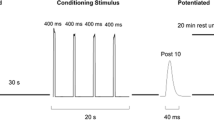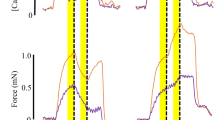Abstract
The influence of moderately elevated extracellular potassium concentration ([K+]) on muscle force has marked similarities to that of posttetanic potentiation (PTP) in that twitch force may be enhanced whilst high-frequency force is depressed. The purpose of this work was to test whether K+-induced potentiation is mechanistically related to PTP via skeletal myosin light-chain kinase (skMLCK)-catalyzed phosphorylation of the myosin regulatory light chains (RLC). To do this, we assessed the influence of elevated [K+] on the force response at various frequencies in extensor digitorum longus (EDL) muscles isolated from wild-type and skeletal myosin light-chain kinase (skMLCK−/−) absent mice. Changing [K+] of the incubation medium from 5 to 10 mmol increased isometric twitch force by a similar amount in wild-type and skMLCK−/− muscles (~ 13% in both genotypes) (all data n = 7–8, P < 0.05). In contrast, 100- and 200-Hz forces were depressed in both genotypes (by 5–7 and 15–18%, respectively). The isometric twitch potentiation caused by a tetanic stimulus series was similar at both [K+] levels for each genotype but was much greater for wild-type than for skMLCK−/− muscles (i.e., 23–25 and 8–9%, respectively). Thus, we conclude that [K+]- and stimulation-induced potentiation are additive and that [K+]-induced potentiation is independent of RLC phosphorylation.





Similar content being viewed by others
References
Brown GL, von Euler US (1938) The after effects of a tetanus on mammalian muscle. J Physiol 93:39–60. https://doi.org/10.1113/jphysiol.1938.sp003623
Bunda J, Gittings W, Vandenboom R (2018) Myosin phosphorylation improves contractile economy of mouse fast skeletal muscle during staircase potentiation J Exp Biol 221. https://doi.org/10.1242/jeb.167718
Cairns SP, Hing WA, Slack JR, Mills RG, Loiselle DS (1997) Different effects of raised [K+]o on membrane potential and contraction in mouse fast- and slow-twitch muscle. Am J Physiol 273:C598-611. https://doi.org/10.1152/ajpcell.1997.273.2.C598
Cairns SP, Leader JP, Loiselle DS (2011) Exacerbated potassium-induced paralysis of mouse soleus muscle at 37 degrees C vis-a-vis 25 degrees C: implications for fatigue. K+ -induced paralysis at 37 degrees C. Pflugers Arch 461:469–479. https://doi.org/10.1007/s00424-011-0927-4
Gittings W, Bunda J, Vandenboom R (2018) Myosin phosphorylation potentiates steady-state work output without altering contractile economy of mouse fast skeletal muscles J ExpBiol 221. https://doi.org/10.1242/jeb.167742
Gittings W, Huang J, Smith IC, Quadrilatero J, Vandenboom R (2011) The effect of skeletal myosin light chain kinase gene ablation on the fatigability of mouse fast muscle. J Muscle Res Cell Motil 31:337–348. https://doi.org/10.1007/s10974-011-9239-8
Grob D, Liljestrand A, Johns RJ (1957) Potassium movement in normal subjects: effect on muscle function. Am J Med 23:340–355. https://doi.org/10.1016/0002-9343(57)90315-7
Holmberg E, Waldeck B (1980) On the possible role of potassium ions in the action of terbutaline on skeletal muscle contractions. Acta Pharmacol Toxicol (Copenh) 46:141–149. https://doi.org/10.1111/j.1600-0773.1980.tb02434.x
MacIntosh BR, Taub EC, Dormer GN, Tomaras EK (2008) Potentiation of isometric and isotonic contractions during high-frequency stimulation. Pflugers Arch 456:449–458. https://doi.org/10.1007/s00424-007-0374-4
Morris SR, Gittings W, Vandenboom R (2018) Epinephrine augments posttetanic potentiation in mouse skeletal muscle with and without myosin phosphorylation. Physiol Rep 6:e13690. https://doi.org/10.14814/phy2.13690
Olesen JH, Herskind J, Pedersen KK, Overgaard K (2021) Potassium-induced potentiation of subtetanic force in rat skeletal muscles: influences of β2-activation, lactic acid, andtemperature. Am J Physiol Cell Physiol 321(5):C884–C896. https://doi.org/10.1152/ajpcell.00120.2021
Padron R, Ma W, Duno-Miranda S, Koubassova N, Lee KH, Pinto A, Alamo L, Bolanos P, Tsaturyan A, Irving T, Craig R (2020) The myosin interacting-heads motif present in live tarantula muscle explains tetanic and posttetanic phosphorylation mechanisms. Proc Natl Acad Sci U S A 117:11865–11874. https://doi.org/10.1073/pnas.1921312117
Pedersen KK, Cheng AJ, Westerblad H, Olesen JH, Overgaard K (2019) Moderately elevated extracellular [K(+)] potentiates submaximal force and power in skeletal muscle via increased [Ca(2+)]i during contractions Am J Physiol Cell Physiol. https://doi.org/10.1152/ajpcell.00104.2019
Persechini A, Stull JT, Cooke R (1985) The effect of myosin phosphorylation on the contractile properties of skinned rabbit skeletal muscle fibers. J Biol Chem 260:7951–7954
Quinonez M, Gonzalez F, Morgado-Valle C, DiFranco M (2010) Effects of membrane depolarization and changes in extracellular [K(+)] on the Ca (2+) transients of fast skeletal muscle fibers. Implications for muscle fatigue. J Muscle Res Cell Motil 31:13–33. https://doi.org/10.1007/s10974-009-9195-8
Rassier DE, Tubman LA, MacIntosh BR (1999) Staircase in mammalian muscle without light chain phosphorylation. Braz J Med Biol Res 32:121–129. https://doi.org/10.1590/s0100-879x1999000100018
Renaud JM, Light P (1992) Effects of K+ on the twitch and tetanic contraction in the sartorius muscle of the frog, Rana pipiens. Implication for fatigue in vivo. Can J Physiol Pharmacol 70:1236–1246. https://doi.org/10.1139/y92-172
Schiaffino S, Reggiani C (2011) Fiber types in mammalian skeletal muscles. Physiol Rev 91:1447–1531. https://doi.org/10.1152/physrev.00031.2010
Sejersted OM, Sjøgaard G (2000) Dynamics and consequences of potassium shifts in skeletal muscle and heart during exercise. Physiol Rev 80:1411–1481. https://doi.org/10.1152/physrev.2000.80.4.1411
Smith IC, Gittings W, Huang J, McMillan EM, Quadrilatero J, Tupling AR, Vandenboom R (2013) Potentiation in mouse lumbrical muscle without myosin light chain phosphorylation: is resting calcium responsible? J Gen Physiol 141:297–308. https://doi.org/10.1085/jgp.201210918
Stull JT, Kamm KE, Vandenboom R (2011) Myosin light chain kinase and the role of myosin light chain phosphorylation in skeletal muscle. Arch Biochem Biophys 510:120–128. https://doi.org/10.1016/j.abb.2011.01.017
Vandenboom R, Gittings W, Smith IC, Grange RW, Stull JT (2013) Myosin phosphorylation and force potentiation in skeletal muscle: evidence from animal models. J Muscle Res Cell Motil 34:317–332. https://doi.org/10.1007/s10974-013-9363-8
Vandenboom R, Grange RW, Houston ME (1993) Threshold for force potentiation associated with skeletal myosin phosphorylation. Am J Physiol 265:C1456-1462. https://doi.org/10.1152/ajpcell.1993.265.6.C1456
Vandenboom R, Grange RW, Houston ME (1995) Myosin phosphorylation enhances rate of force development in fast-twitch skeletal muscle. Am J Physiol 268:C596-603. https://doi.org/10.1152/ajpcell.1995.268.3.C596
Walker SM (1948) Action potentials in rat muscle with twitch tension potentiated by KCI treatment, adrenalectomy, tetanus and treppe. Am J Physiol 154:63–72. https://doi.org/10.1152/ajplegacy.1948.154.1.63
Westerblad H, Bruton JD, Katz A (2010) Skeletal muscle: energy metabolism, fiber types, fatigue and adaptability. Exp Cell Res 316:3093–3099. https://doi.org/10.1016/j.yexcr.2010.05.019
Yensen C, Matar W, Renaud JM (2002) K+-induced twitch potentiation is not due to longer action potential. Am J Physiol Cell Physiol 283:C169–C177. https://doi.org/10.1152/ajpcell.1997.273.2.C598
Zhi G, Ryder JW, Huang J, Ding P, Chen Y, Zhao Y, Kamm KE, Stull JT (2005) Myosin light chain kinase and myosin phosphorylation effect frequency-dependent potentiation of skeletal muscle contraction. Proc Natl Acad Sci U S A 102:17519–17524. https://doi.org/10.1073/pnas.0506846102
Aagaard P (2003) Training-induced changes in neural function. Exerc Sport Sci Rev 31:61–67. https://doi.org/10.1097/00003677-200304000-00002
Aagaard P, Magnusson PS, Larsson B, Kjaer M, Krustrup P (2007) Mechanical muscle function, morphology, and fiber type in lifelong trained elderly. Med Sci Sports Exerc 39:1989–1996. https://doi.org/10.1249/mss.0b013e31814fb402
Acknowledgements
The authors thank Val Andrew Fajardo for valuable guidance and methodological input and Sebastian Silvera for technical assistance.
Author information
Authors and Affiliations
Contributions
Kristian Overgaard and Rene Vandenboom contributed to the study conception and design. All authors contributed to data collection and analysis and to writing and commenting on previous versions of the manuscript. All authors read and approved the final manuscript.
Corresponding author
Ethics declarations
Conflict of interest
The authors declare no competing interests.
Additional information
Publisher’s note
Springer Nature remains neutral with regard to jurisdictional claims in published maps and institutional affiliations.
Rights and permissions
About this article
Cite this article
Overgaard, K., Gittings, W. & Vandenboom, R. Potentiation of force by extracellular potassium and posttetanic potentiation are additive in mouse fast-twitch muscle in vitro. Pflugers Arch - Eur J Physiol 474, 637–646 (2022). https://doi.org/10.1007/s00424-022-02681-z
Received:
Revised:
Accepted:
Published:
Issue Date:
DOI: https://doi.org/10.1007/s00424-022-02681-z




